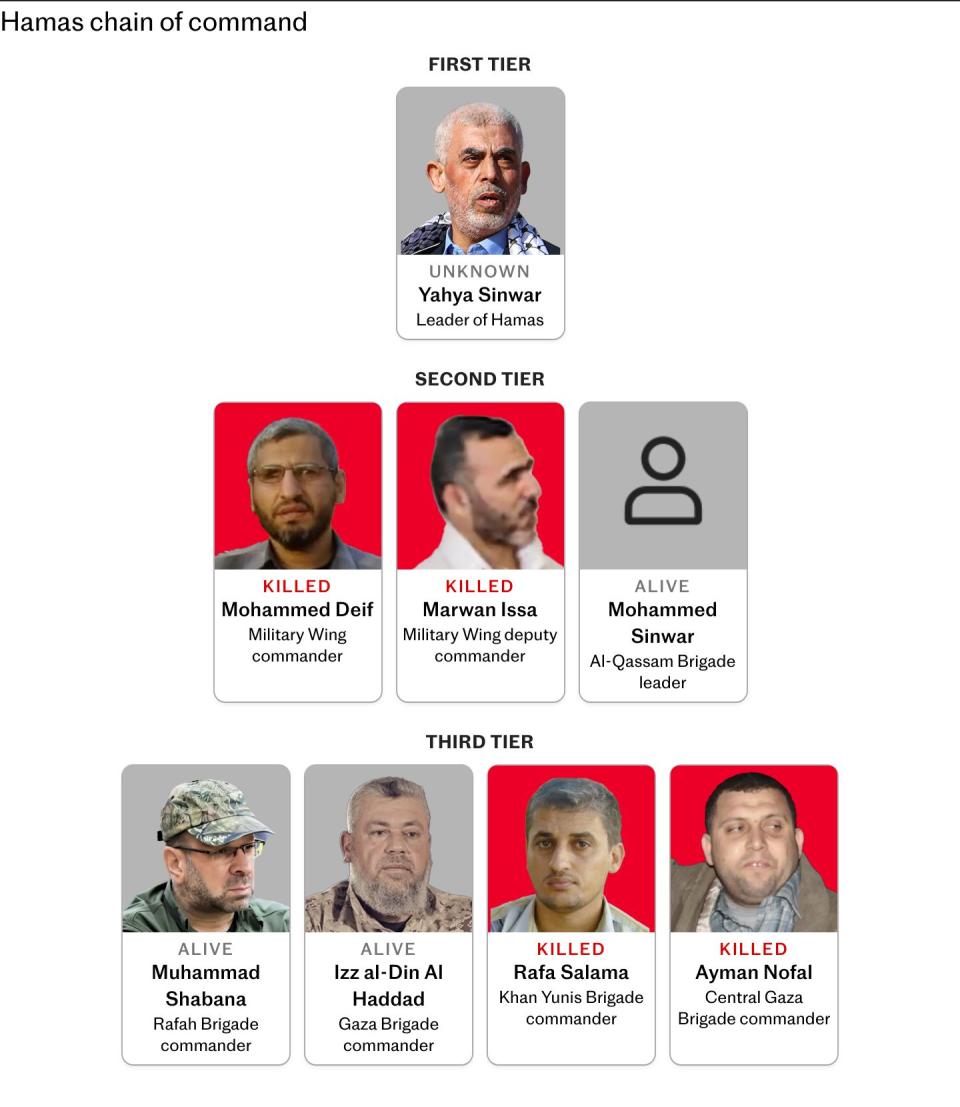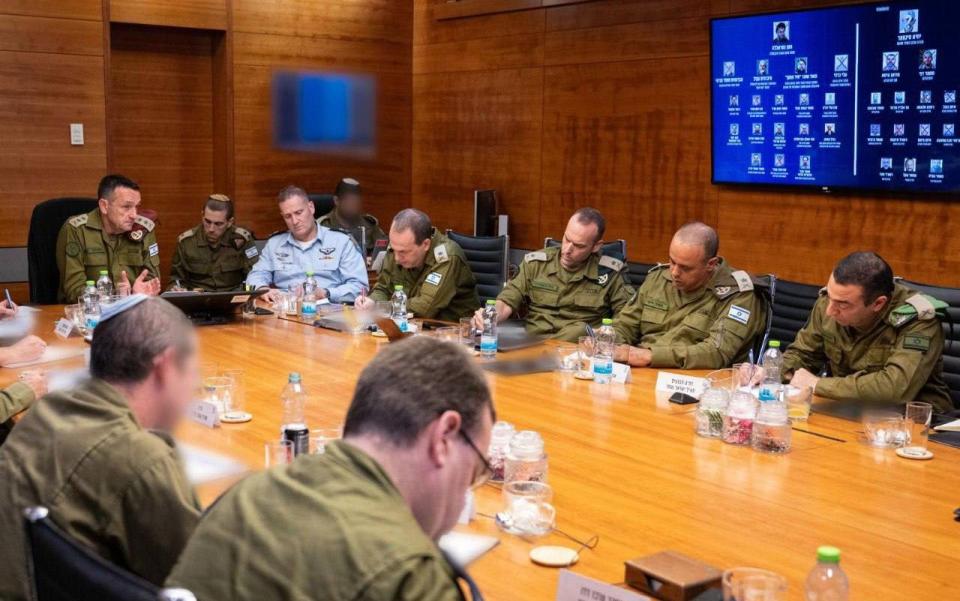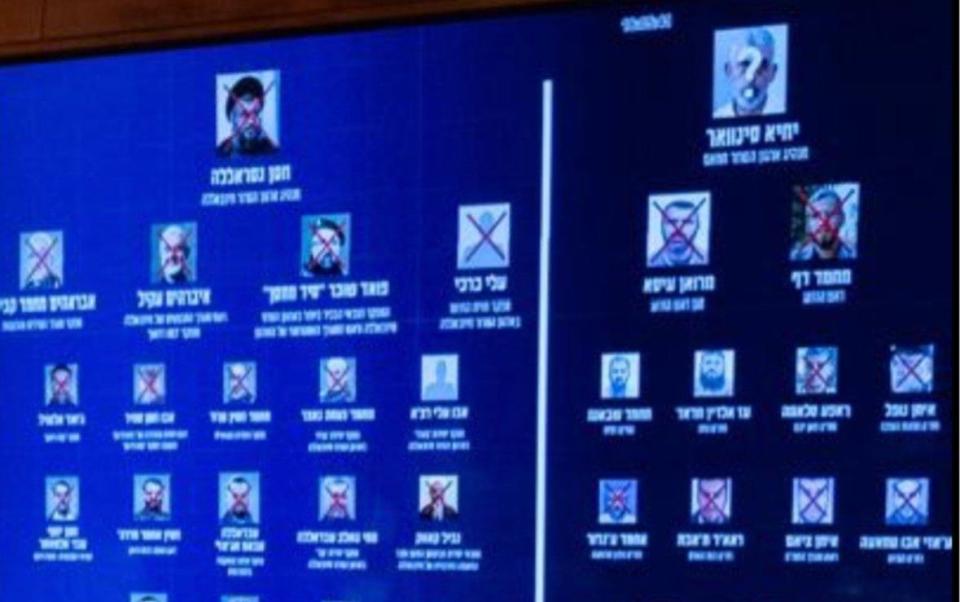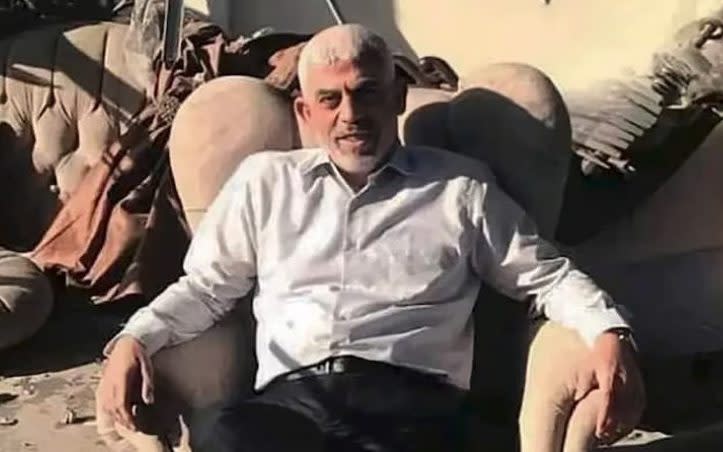In a windowless room, somewhere in the bowels of the Israeli Defense Forces (IDF) headquarters, Chief of Staff Lieutenant General Herzi Halevi extended his index finger.
Israel had just assassinated the Hezbollah leader and was about to invade Lebanon when he called on his generals and commanders to follow instructions.
But photos of the meeting released to the press showed a seemingly unrelated image in the background.
A screen mounted on the wood-paneled wall shows fourteen photos of the Hamas command structure – most with a giant red cross above them to indicate they have been killed.
At the top of the chain was public enemy No. 1, Hamas leader Yahya Sinwar, with his gray hair and salt-and-pepper beard. For the first time since the war began, he had a question mark above his head.
The image sparked a new round of speculation that Israel's most wanted man, the man who planned and ordered the October 7 massacres, was finally dead.
Just over a week until the anniversary of the terrorist attacks next Monday: was it possible that the IDF finally got their man?


Rumors of his possible death had arisen a few weeks earlier when intelligence officials began reporting that one of the precision airstrikes that razed Gaza may have killed the leader.
No concrete evidence has emerged since then, but the pattern follows similar high-level killings in Gaza that took several weeks to be publicly announced.
Two well-placed Israeli officials told The Telegraph that the defense establishment believes Sinwar is now dead.
One of the sources said that “it is very likely that Yahya Sinwar was eliminated during one of the IDF attacks. The assessments of the Israeli security leadership suggest that Sinwar was most likely murdered.”
However, a lot of caution remains necessary. Skeptics question the timing surrounding the October 7 commemoration and how Israel could have killed a man who was reportedly hidden deep underground and, according to reports, surrounded by Israeli hostages.
Sinwar could have decided that the best way to keep himself safe while assassinations bring down his top leaders is to withdraw completely from view. US officials told the New York Times they believed Sinwar is still alive and making important decisions for Hamas.
The clues
Israeli sources told The Telegraph that one piece of evidence that emerged about his possible death was the end of communications with the leader.
One source said handwritten notes delivered by couriers keeping hostage negotiations alive had dried up.
However, Israel also announced on Thursday that it had killed Sinwar's right-hand man about three months ago. Rawhi Mushtaha was reportedly among those involved in the complex human chain of delivering the notes.
Israel's intelligence machine has used courier tracking in the past, most notably to find and kill Hamas military chief Mohammed Deif, who was killed in an airstrike in Gaza in July. The US used a similar technique to find Osama bin Laden.
Sources suggested that the Israeli defense establishment is currently in a situation similar to that when an airstrike on Mr Deif in Khan Younis took place on July 13. Official confirmation of his death was announced almost three weeks later, on August 1.
Sinwar was appointed political leader of Hamas after Ishmail Haniyeh was killed in an alleged Israeli attack in Tehran in July, making him the terror group's all-powerful figure.
Widely seen as the architect behind the October 7 massacre, he is considered the most valuable target for Israel, which refers to him as a “dead man walking.”
Israeli forces have been scouring Gaza for Sinwar since they invaded the enclave in late October and have even come close to capturing him several times. The IDF determined early in the war that the Hamas leader was hiding in southern Gaza, specifically in a tunnel deep underground.
In February, the IDF published the first images of Sinwar since October 7, showing his children and wife walking through a tunnel under a cemetery in the Bani Suheila area of Khan Younis.
Sinwar is seen wearing slippers and carrying a bag walking through the tunnel behind his family on October 10, but Israeli soldiers only reached the tunnel in February where they found the surveillance footage.
IDF spokesman Daniel Hagari said the tunnel from which Sinwar escaped before Israeli forces arrived “contained bedrooms of senior Hamas officials and the office of the commander of the Eastern Battalion of the Khan Younis Brigade, from where he led the attack on October 7.” .
Senior Hamas officials stayed at the compound in “comfortable conditions” with food and bathrooms, along with safes containing “personal funds of millions of shekels and dollars in cash,” Mr. Hagari added.
In December, Netanyahu announced that Israeli forces had surrounded Sinwar's home in Khan Younis.
“I said last night that our troops could reach anywhere in the Gaza Strip. Now they surround Sinwar's house. His house is not his fortress, and while he may flee, it is only a matter of time before we catch him,” Netanyahu said.
In August, the outgoing commander of the IDF's 98th Division, Brig. General Dan Goldfus told Channel 12 that the military was “minutes” away from capturing the Hamas leader.
“We were close. We were on his property. We came to an underground complex. We found a lot of money there. The coffee was still hot. Weapons are scattered,” Goldfus said.




And as Israel continues to assassinate Hamas commanders, Mr. Sinwar is running out of hiding places.
“Every day he has trouble finding places to hide. The list of associates and confidants is being shortened,” a security source told the Jerusalem Post in August.
But Israel also faces a much wider and more complex network of tunnels than they believed existed before the invasion.
Then gathering intelligence remains the key.
The hunt
Hunters fall under an umbrella of units under the Israeli Security Service, including intelligence officers, Israeli Defense Forces (IDF) special operations units, military engineers and surveillance experts.
Teams of experts entering the tunnels, such as the Special Section of the Combat Engineering Corps, are armed with ground-based radar.
A special section within the Combat Engineering Corps, Yahalom has more experience in tunnel warfare than any of its counterparts in the Western militaries and has access to state-of-the-art U.S. ground-based radar.
Many clues have surfaced in Hamas complexes revealing everything from the plans, orders, maps and blueprints of the terror group's compound structures.
Seized computers, documents and surveillance footage all helped keep the trail warm.
“Hundreds of thousands of interrogations of terrorists and senior leaders in such a short period would not have yielded such in-depth information about their methods of order and organization,” a military official said in July.
But the interrogations of thousands of members of Hamas and other terror groups arrested since October 7 have also helped.
They have so far led the IDF to find tunnels and weapons depots and to reveal hospitals and Red Crescent facilities that Hamas allegedly uses to operate.


“Every investigation leads to new locations being implicated, and the human intelligence that emerges… is an inseparable layer of the entire intelligence picture,” the IDF said in November.
The importance of monitoring Sinwar's communications with other members has also become apparent.
Previously, Israel's secret intelligence unit 8200 was used to listen in on Hamas communications.
But their role has diminished since Hamas's leadership abandoned all electronic communications in favor of notes and verbal messages from runners.
“Using complex means, he communicates with all leaders of the movement, both inside (Gaza) and abroad, as well as with the (Ezzedine) al-Qassam Brigades,” a senior Hamas leader told AfP.
“He follows complex security procedures for his personal protection, but this does not prevent him from continuing his duties and making decisions,” he added.
The consequences
If Mr Sinwar was murdered, it raises a number of questions.
Khaled Meshaal, the former leader of Hamas, may be the only person who can fill his shoes and effectively rule the terror group, albeit from abroad and not within Gaza.
There is also the possibility that hostages were killed in the same attack on Sinwar.
If so, the Israeli government will be angered by the vast majority of the public who want a ceasefire agreement with Hamas.
In theory, killing Sinwar could give Netanyahu the victory he needs to sign a deal that could end the war and release the remaining hostages.
Khalil al-Hayya, Hamas's deputy leader, currently represents the terrorist group in the negotiations, which have notably been stalled for weeks.
But since he has no mandate to make a deal himself, there will be no ceasefire until Mr Sinwar shows signs of life and reengages with mediators, or he is declared dead and a new leader is appointed. .
Giora Eiland, former head of Israel's National Security Council, told The Telegraph that there are certainly “signs” that Sinwar has been killed.
But he added that he has not received any information from Israeli officials he has spoken to in recent weeks.
“It's still a mystery,” he said.
Netanyahu's speech on Sunday raised eyebrows when Sinwar was mentioned among other commanders killed by Israel.
“The regime in Tehran does not understand our determination to defend ourselves and demand a price from our enemies. Sinwar and Deif did not understand this; Neither do Nasrallah and Mohsen,” Netanyahu said.
Broaden your horizons with award-winning British journalism. Try The Telegraph free for 3 months with unlimited access to our award-winning website, exclusive app, money-saving offers and more.

